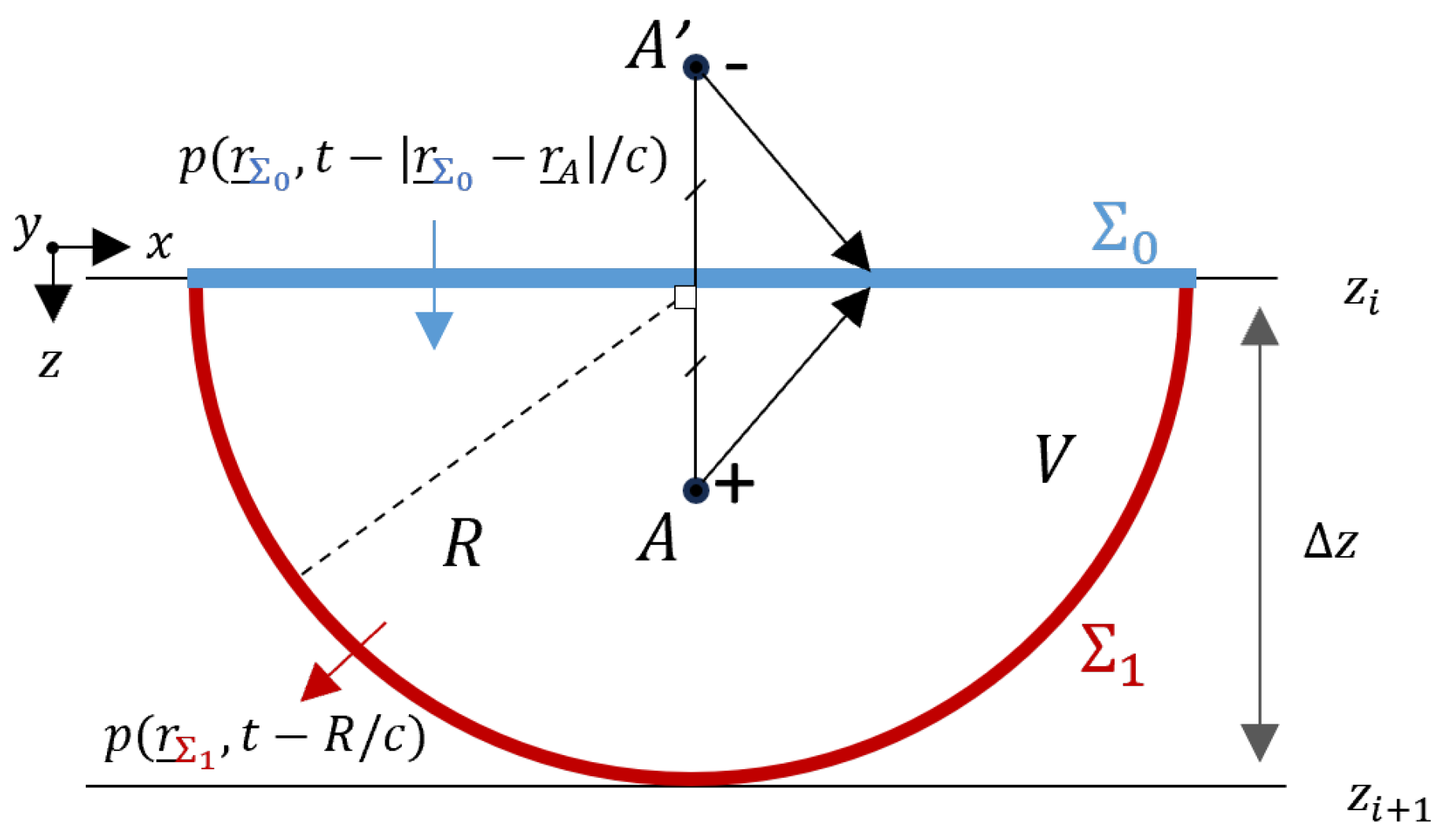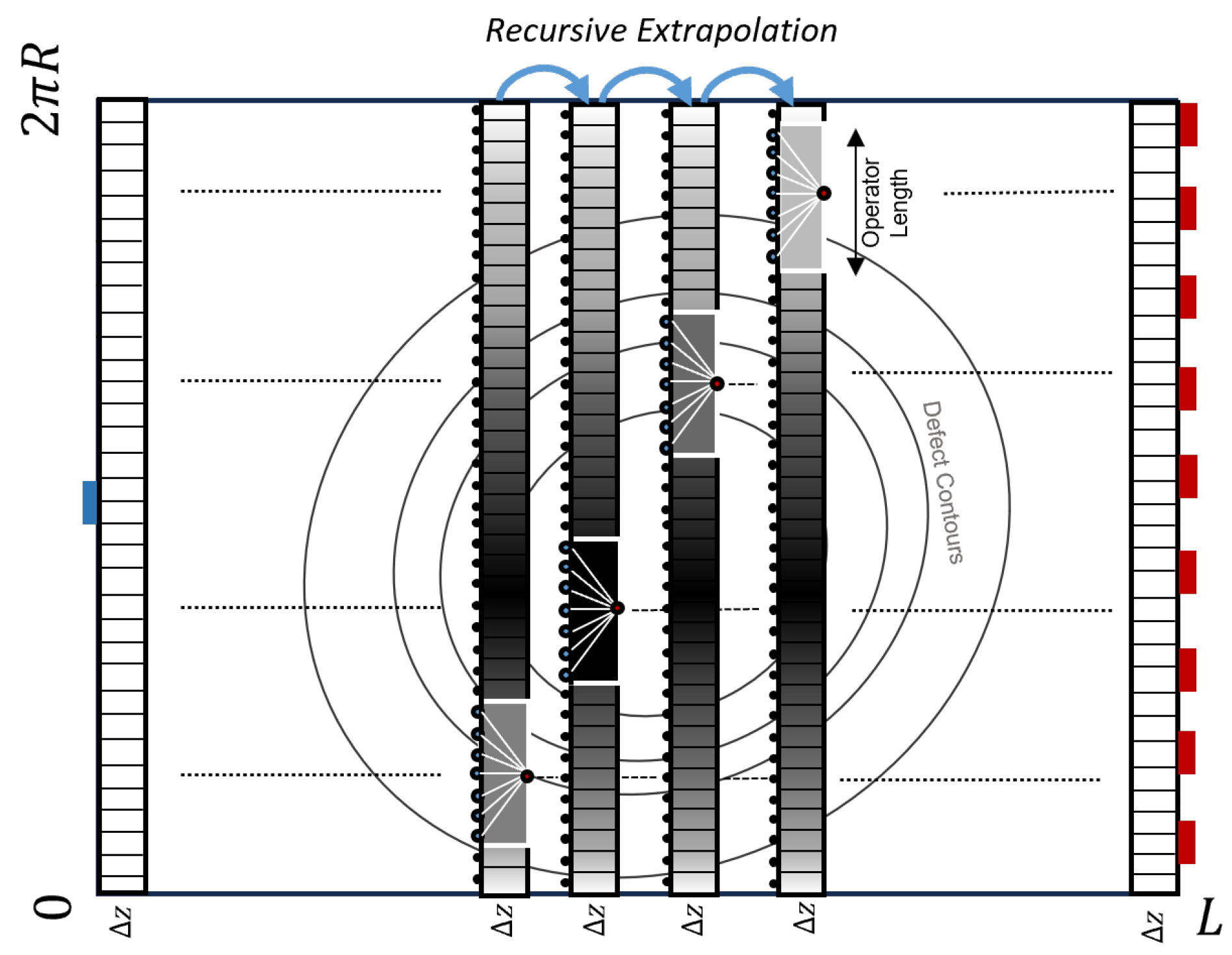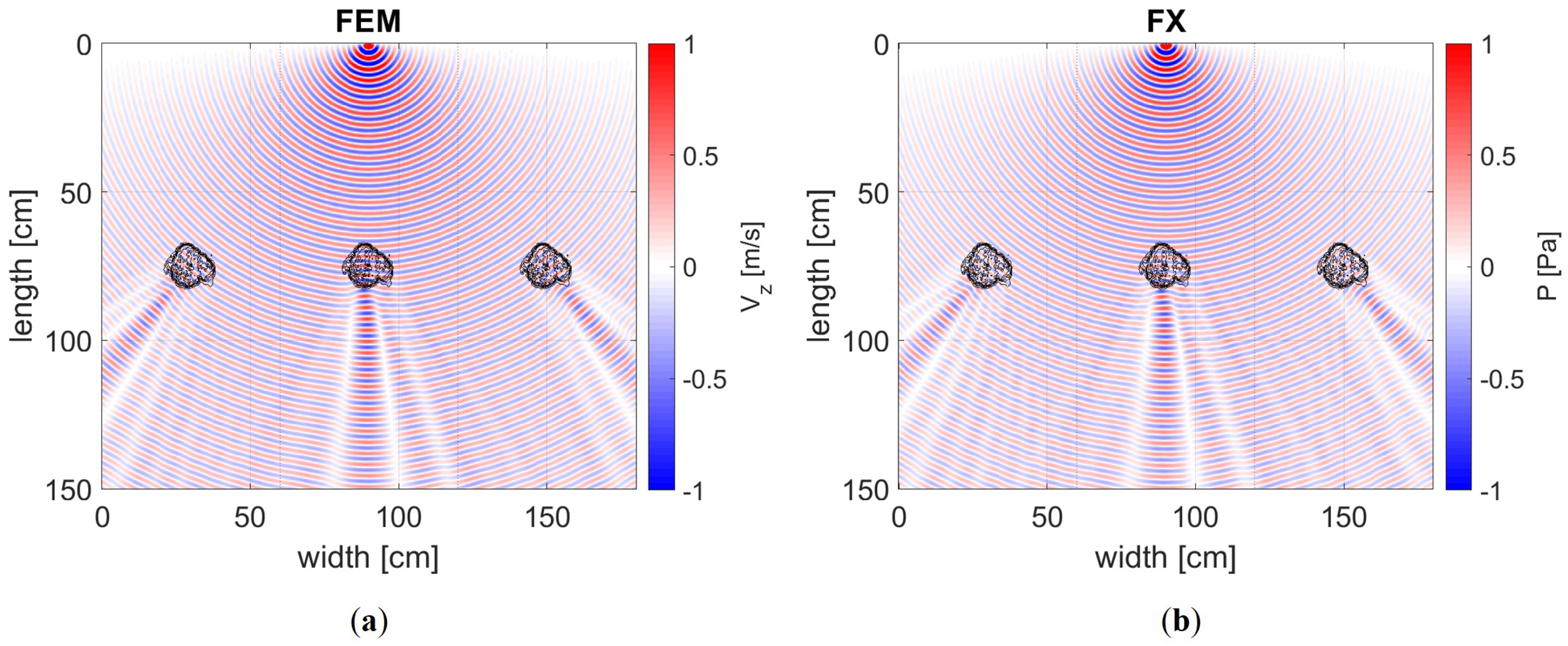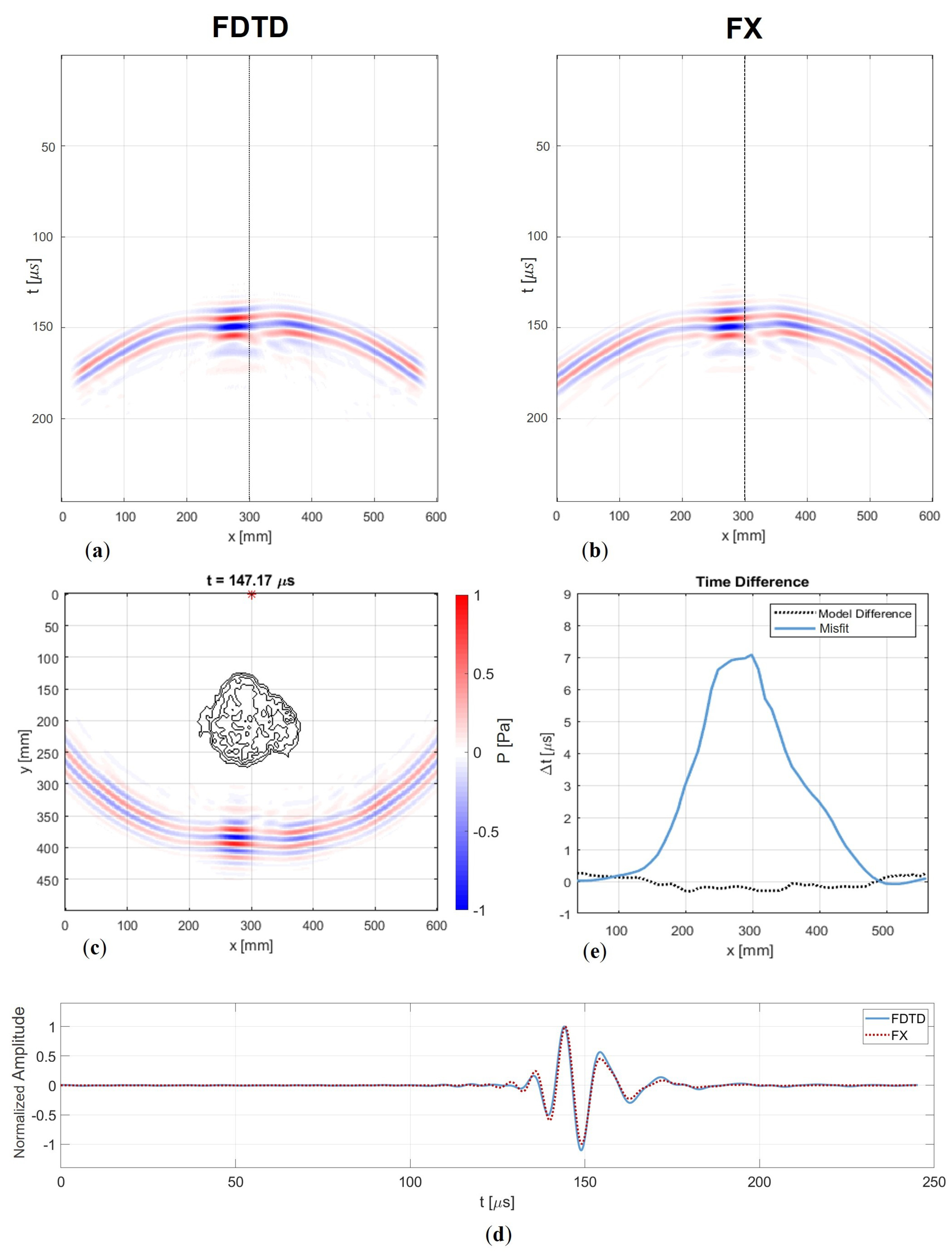Efficient Guided Wave Modelling for Tomographic Corrosion Mapping via One-Way Wavefield Extrapolation
Abstract
:1. Introduction
2. Background
2.1. Guided Waves
2.2. Wavefield Extrapolation
Rayleigh II — Integral
3. Extrapolation Operators
4. Methods
4.1. Numerical Validation
4.1.1. Finite Element Modelling in the Frequency Domain
4.1.2. Finite Difference Modelling in the Time Domain
4.2. Mode Excitation
4.3. Experimental Set-Up
5. Results
5.1. Frequency Domain Modelling
5.2. Arrival Time and Amplitude Differences
5.3. Experimental Results
6. Conclusions
Author Contributions
Funding
Institutional Review Board Statement
Informed Consent Statement
Data Availability Statement
Acknowledgments
Conflicts of Interest
References
- Rose, J.L. Ultrasonic Guided Waves in Solid Media, 1st ed.; Cambridge University Press: Cambridge, UK, 2014. [Google Scholar] [CrossRef]
- Cawley, P.; Alleyne, D. The use of Lamb waves for the long range inspection of large structures. Ultrasonics 1996, 34, 287–290. [Google Scholar] [CrossRef]
- Huthwaite, P.; Ribichini, R.; Cawley, P.; Lowe, M.J.S. Mode selection for corrosion detection in pipes and vessels via guided wave tomography. IEEE Trans. Ultrason. Ferroelectr. Freq. Control 2013, 60, 1165–1177. [Google Scholar] [CrossRef] [PubMed]
- Leonard, K.R.; Hinders, M.K. Lamb wave tomography of pipe-like structures. Ultrasonics 2005, 43, 574–583. [Google Scholar] [CrossRef]
- Huthwaite, P.; Simonetti, F. High-resolution guided wave tomography. Wave Motion 2013, 50, 979–993. [Google Scholar] [CrossRef]
- Volker, A.; van Zon, T. Guided wave travel time tomography for bends. AIP Conf. Proc. 2013, 1511, 737–744. [Google Scholar] [CrossRef]
- Volker, A. Guided wave tomography in anisotropic media using recursive extrapolation operators. AIP Conf. Proc. 2018, 1949, 090001. [Google Scholar] [CrossRef]
- Zimmermann, A.A.E.; Huthwaite, P.; Pavlakovic, B. High-resolution thickness maps of corrosion using SH1 guided wave tomography. Proc. R. Soc. A Math. Phys. Eng. Sci. 2021, 477, 20200380. [Google Scholar] [CrossRef]
- Huthwaite, P. Evaluation of inversion approaches for guided wave thickness mapping. Proc. R. Soc. A Math. Phys. Eng. Sci. 2014, 470, 20140063. [Google Scholar] [CrossRef]
- Belanger, P.; Cawley, P.; Thompson, D.O.; Chimenti, D.E. Lamb Wave Tomogrpahy to Evaluate the Maximum Depth of Corrosion Patches. AIP Conf. Proc. 2008, 975, 1290–1297. [Google Scholar] [CrossRef]
- Belanger, P.; Cawley, P. Feasibility of low frequency straight-ray guided wave tomography. NDT & E Int. 2009, 42, 113–119. [Google Scholar] [CrossRef]
- Belanger, P.; Cawley, P.; Simonetti, F. Guided wave diffraction tomography within the born approximation. IEEE Trans. Ultrason. Ferroelectr. Freq. Control 2010, 57, 1405–1418. [Google Scholar] [CrossRef] [PubMed]
- Huthwaite, P. Guided wave tomography with an improved scattering model. Proc. R. Soc. A Math. Phys. Eng. Sci. 2016, 472, 20160643. [Google Scholar] [CrossRef] [PubMed]
- Huthwaite, P. Improving accuracy through density correction in guided wave tomography. Proc. R. Soc. A Math. Phys. Eng. Sci. 2016, 472, 20150832. [Google Scholar] [CrossRef] [PubMed]
- Li, J.; Rose, J.L. Excitation and propagation of non-axisymmetric guided waves in a hollow cylinder. J. Acoust. Soc. Am. 2001, 109, 457–464. [Google Scholar] [CrossRef] [PubMed]
- Li, J.; Rose, J.L. Natural beam focusing of non-axisymmetric guided waves in large-diameter pipes. Ultrasonics 2006, 44, 35–45. [Google Scholar] [CrossRef] [PubMed]
- Luo, W.; Zhao, X.; Rose, J.L. A Guided Wave Plate Experiment for a Pipe. J. Press. Vessel. Technol. 2005, 127, 345–350. [Google Scholar] [CrossRef]
- Velichko, A.; Wilcox, P.D. Excitation and scattering of guided waves: Relationships between solutions for plates and pipes. J. Acoust. Soc. Am. 2009, 125, 9. [Google Scholar] [CrossRef] [PubMed]
- Brath, A.J.; Simonetti, F.; Nagy, P.B.; Instanes, G. Guided Wave Tomography of Pipe Bends. IEEE Trans. Ultrason. Ferroelectr. Freq. Control 2017, 64, 847–858. [Google Scholar] [CrossRef] [PubMed]
- Wang, Z.; Huang, S.; Shen, G.; Wang, S.; Zhao, W. High resolution tomography of pipeline using multi-helical Lamb wave based on compressed sensing. Constr. Build. Mater. 2022, 317, 125628. [Google Scholar] [CrossRef]
- Druet, T.; Tastet, J.L.; Chapuis, B.; Moulin, E. Guided Wave Tomography for Corrosion Monitoring in Planar Structures. In Proceedings of the Structural Health Monitoring 2017, Stanford, CA, USA, September 2017. [Google Scholar] [CrossRef]
- Volker, A.; Bloom, J.; Thompson, D.O.; Chimenti, D.E. Experimental Results of Guided Wave Travel Time Tomography. AIP Conf. Proc. 2011, 1335, 215–222. [Google Scholar] [CrossRef]
- Willey, C.; Simonetti, F.; Nagy, P.; Instanes, G. Guided wave tomography of pipes with high-order helical modes. NDT & E Int. 2014, 65, 8–21. [Google Scholar] [CrossRef]
- Virieux, J. (Ed.) An Introduction to Full Waveform Inversion. In Encyclopedia of Exploration Geophysics; Society of Exploration Geophysicists, SEG: Houston, TX, USA, 2014; pp. R1-1–R1-40. [Google Scholar] [CrossRef]
- Bozdağ, E.; Trampert, J.; Tromp, J. Misfit functions for full waveform inversion based on instantaneous phase and envelope measurements: Misfit functions for full waveform inversion. Geophys. J. Int. 2011, 185, 845–870. [Google Scholar] [CrossRef]
- Fichtner, A. Full Seismic Waveform Modelling and Inversion; Advances in Geophysical and Environmental Mechanics and Mathematics; Springer: Berlin/Heidelberg, Germany, 2011. [Google Scholar] [CrossRef]
- Rao, J.; Ratassepp, M.; Fan, Z. Guided Wave Tomography Based on Full Waveform Inversion. IEEE Trans. Ultrason. Ferroelectr. Freq. Control 2016, 63, 737–745. [Google Scholar] [CrossRef]
- Rao, J.; Ratassepp, M.; Fan, Z. Investigation of the reconstruction accuracy of guided wave tomography using full waveform inversion. J. Sound Vib. 2017, 400, 317–328. [Google Scholar] [CrossRef]
- Rao, J.; Ratassepp, M.; Fan, Z. Limited-view ultrasonic guided wave tomography using an adaptive regularization method. J. Appl. Phys. 2016, 120, 194902. [Google Scholar] [CrossRef]
- Zuo, P.; Huthwaite, P. Quantitative mapping of thickness variations along a ray path using geometrical full waveform inversion and guided wave mode conversion. Proc. R. Soc. A Math. Phys. Eng. Sci. 2022, 478, 20210602. [Google Scholar] [CrossRef]
- Rasgado-Moreno, C.O.; Rist, M.; Land, R.; Ratassepp, M. Acoustic Forward Model for Guided Wave Propagation and Scattering in a Pipe Bend. Sensors 2022, 22, 486. [Google Scholar] [CrossRef] [PubMed]
- Brath, A.J.; Simonetti, F.; Nagy, P.B.; Instanes, G. Acoustic formulation of elastic guided wave propagation and scattering in curved tubular structures. IEEE Trans. Ultrason. Ferroelectr. Freq. Control 2014, 61, 815–829. [Google Scholar] [CrossRef] [PubMed]
- Gazdag, J. Wave equation migration with the phase-shift method. Geophysics 1978, 43, 1342–1351. [Google Scholar] [CrossRef]
- Berkhout, A.J. Wave field extrapolation techniques in seismic migration, a tutorial. Geophysics 1981, 46, 1638–1656. [Google Scholar] [CrossRef]
- Berkhout, A.J. Seismic Migration: Imaging of Acoustic Energy by Wave Field Extrapolation, 2nd ed.; Number 14A-14B in Developments in Solid Earth Geophysics; Elsevier Scientific Pub. Co., Ltd.: Amsterdam, The Netherlands; New York, NY, USA, 1982. [Google Scholar]
- Holberg, O. Towards optimum one-way wave propagation. Geophys. Prospect. 1988, 36, 99–114. [Google Scholar] [CrossRef]
- Hale, D. Stable explicit depth extrapolation of seismic wavefields. Geophysics 1991, 56, 1770–1777. [Google Scholar] [CrossRef]
- Nautiyal, A.; Gray, S.H.; Whitmore, N.D.; Garing, J.D. Stability versus accuracy for an explicit wavefield extrapolation operator. Geophysics 1993, 58, 277–283. [Google Scholar] [CrossRef]
- Sollid, A.; Arntsen, B. Cost-effective 3D one-pass depth migration. Geophys. Prospect. 1994, 42, 755–776. [Google Scholar] [CrossRef]
- Thorbecke, J.W.; Berkhout, A.J. 3-D recursive extrapolation operators: An overview. In SEG Technical Program Expanded Abstracts 1994; Society of Exploration Geophysicists: Houston, TX, USA, 1994; pp. 1262–1265. [Google Scholar] [CrossRef]
- Berkhout, A.J.; De Vries, D.; Baan, J.; Van Den Oetelaar, B.W. A wave field extrapolation approach to acoustical modeling in enclosed spaces. J. Acoust. Soc. Am. 1999, 105, 1725–1733. [Google Scholar] [CrossRef]
- Portzgen, N.; Gisolf, D.; Blacquiere, G. Inverse wave field extrapolation: A different NDI approach to imaging defects. IEEE Trans. Ultrason. Ferroelectr. Freq. Control 2007, 54, 118–127. [Google Scholar] [CrossRef]
- Brath, A.J.; Simonetti, F.; Nagy, P.B.; Instanes, G. Experimental Validation of a Fast Forward Model for Guided Wave Tomography of Pipe Elbows. IEEE Trans. Ultrason. Ferroelectr. Freq. Control 2017, 64, 859–871. [Google Scholar] [CrossRef]
- Virieux, J. P-SV wave propagation in heterogeneous media: Velocity-stress finite-difference method. Geophysics 1986, 51, 889–901. [Google Scholar] [CrossRef]
- Gazdag, J.; Sguazzero, P. Migration of seismic data by phase shift plus interpolation. Geophysics 1984, 49, 124–131. [Google Scholar] [CrossRef]
- Blacquière, G. 3D Wave Field Extrapolation in Seismic Depth Migration; OCLC: 21028461; Gebotekst: Zoetermeer, The Netherlands, 1989. [Google Scholar]
- Thorbecke, J.W.; Wapenaar, K.; Swinnen, G. Design of one-way wavefield extrapolation operators, using smooth functions in WLSQ optimization. Geophysics 2004, 69, 1037–1045. [Google Scholar] [CrossRef]
- Thorbecke, J.W. Common Focus Point Technology. Ph.D. Thesis, TU Delft, Delft, The Netherlands, 1997. [Google Scholar]
- van Veldhuizen, E.J. Integrated Approach to 3-D Seismic Acquisition Geometry Analysis: Emphasizing the Influence of the Inhomogeneous Subsurface. Ph.D. Thesis, TU Delft, Delft, The Netherlands, 2006. [Google Scholar]
- Thomsen, L. Weak elastic anisotropy. Geophysics 1986, 51, 13. [Google Scholar] [CrossRef]
- Alkhalifah, T. An acoustic wave equation for anisotropic media. Geophysics 2000, 65, 1239–1250. [Google Scholar] [CrossRef]
- Zhang, J.; Verschuur, D.; Wapenaar, C. Depth migration of shot records in heterogeneous, transversely isotropic media using optimum explicit operators. Geophys. Prospect. 2001, 49, 287–299. [Google Scholar] [CrossRef]
- Thorbecke, J.; Wapenaar, K. Improved extrapolation operator design with the WLSQ method. In SEG Technical Program Expanded Abstracts 2003; Society of Exploration Geophysicists: Houston, TX, USA, 2003; pp. 1146–1149. [Google Scholar] [CrossRef]
- Blacquière, G.; Debeye, H.W.J.; Wapenaar, C.P.A.; Berkhout, A.J. 3D Table-driven migration. Geophys. Prospect. 1989, 37, 925–958. [Google Scholar] [CrossRef]
- Saenger, E.H.; Gold, N.; Shapiro, S.A. Modeling the propagation of elastic waves using a modified finite-difference grid. Wave Motion 2000, 31, 77–92. [Google Scholar] [CrossRef]
- Saenger, E.H.; Bohlen, T. Finite-difference modeling of viscoelastic and anisotropic wave propagation using the rotated staggered grid. Geophysics 2004, 69, 583–591. [Google Scholar] [CrossRef]
- Volker, A.; Vrolijk, J.; Merks-Swolfs, E.; Van Der Burg, D.; Van Der Heiden, M.; Martina, Q. Non-Contact MEMS-Sensor Array Inspection of Composites and Metallic Parts Using Lamb Waves. J. Nondestruct. Eval. Diagn. Progn. Eng. Syst. 2023, 6, 041002. [Google Scholar] [CrossRef]
- Flynn, E.B.; Chong, S.Y.; Jarmer, G.J.; Lee, J.R. Structural imaging through local wavenumber estimation of guided waves. NDT & E Int. 2013, 59, 1–10. [Google Scholar] [CrossRef]
- Lugovtsova, Y.; Bulling, J.; Mesnil, O.; Prager, J.; Gohlke, D.; Boller, C. Damage quantification in an aluminium-CFRP composite structure using guided wave wavenumber mapping: Comparison of instantaneous and local wavenumber analyses. NDT & E Int. 2021, 122, 102472. [Google Scholar] [CrossRef]















Disclaimer/Publisher’s Note: The statements, opinions and data contained in all publications are solely those of the individual author(s) and contributor(s) and not of MDPI and/or the editor(s). MDPI and/or the editor(s) disclaim responsibility for any injury to people or property resulting from any ideas, methods, instructions or products referred to in the content. |
© 2024 by the authors. Licensee MDPI, Basel, Switzerland. This article is an open access article distributed under the terms and conditions of the Creative Commons Attribution (CC BY) license (https://creativecommons.org/licenses/by/4.0/).
Share and Cite
Hassefras, E.; Volker, A.; Verweij, M. Efficient Guided Wave Modelling for Tomographic Corrosion Mapping via One-Way Wavefield Extrapolation. Sensors 2024, 24, 3750. https://doi.org/10.3390/s24123750
Hassefras E, Volker A, Verweij M. Efficient Guided Wave Modelling for Tomographic Corrosion Mapping via One-Way Wavefield Extrapolation. Sensors. 2024; 24(12):3750. https://doi.org/10.3390/s24123750
Chicago/Turabian StyleHassefras, Emiel, Arno Volker, and Martin Verweij. 2024. "Efficient Guided Wave Modelling for Tomographic Corrosion Mapping via One-Way Wavefield Extrapolation" Sensors 24, no. 12: 3750. https://doi.org/10.3390/s24123750





